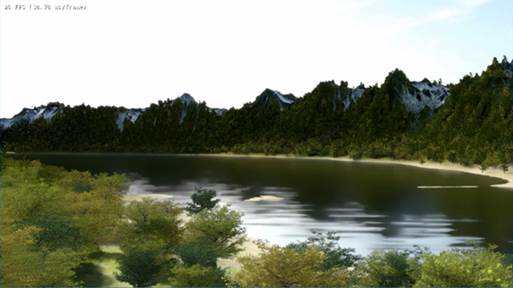Chaos Group presents photorealistic computer graphics rendering at up to 90 frames per second on Nvidia Turing-based Quadro RTX GPUs.
Forest animation rendered in realtime with Chaos’ new Lavina technology. The scene has over 300 billion triangles and 80,000 instances running at 24–30 frames per second with no rasterized graphics or reduced level of detail as might be used for game engine rendering. In this case, the render was performed on Nvidia’s Quadro RTX GPUs.
Chaos Group showcased its new technology, Project Lavina, at Siggraph this year. The company says this is a major breakthrough for realtime rendering because the scene can be rendered directly as it is created without being exported to a game engine. In other words, it is rendered true to the artists’ vision without the intermediate conversion that would happen with import to a game engine. Game engines have their own tricks to accomplish realtime renders, which can affect the final look. Instead, Project Lavina promises direct compatibility and translation of V-Ray assets.
The tech demo uses 3D scenes directly exported from V-Ray enabled applications. Once the scene is loaded in Lavina, users can explore the environment as they would in a game engine, and see the physically accurate lighting, reflections, and global illumination as they will appear when rendered.
The company says this is their second realtime announcement in the last year. The company also announced V-Ray for Unreal, now in beta. As a result, the company says customers have a choice in the workflow they use: game engine or directly from the supported application.
Lavina is the Bulgarian word for avalanche and the company is convinced their new technology has the potential to sweep away current workflows and open up new capabilities for 3D artists and content creators. “We’ve been developing ray tracing for 20 years, and this is one of the biggest breakthroughs we’ve ever made,” says Vlado Koylazov, co-founder and CTO at Chaos Group.
The opportunity for Chaos Group is that they are taking over a significant piece of the gaming engine value proposition and enabling different types of applications to access realtime rendering. The company mentions applications such as virtual productions and VR, 3D configurators and we’re thinking CAD walkthroughs, product demos, etc., also fall into this category.
Peter Mitev, CEO of Chaos Group credits Nvidia and their new Turing architecture with making Lavina possible. From here on, he says, Project Lavina’s mission will be to focus on pushing the quality and speed of realtime ray tracing.
In other news
Chaos also announced V-Ray for Houdini. Houdini is especially strong in particle effects including clouds and vapor, stuff that has volume. It has its own renderer called Mantra, but according to Chaos Group’s CCO Lon Grohs, customers want to use the same renderer throughout the entire content creation pipeline to ensure a consistent look. It’s pretty much the same argument that Chaos is using about game engines: it’s better to be able to render everything in one program, and Chaos is building their product to support as many products as possible. The challenge for any company is that specialized products may not have enough customers to justify a special build. Chaos had made their product for rendering Houdini content available on GitHub. The fact that they’ve completely productized a version, suggests the base for Houdini is growing. Also, the Side Effects team is also aggressively moving to make Houdini interoperable with a wide range of products. It’s a chicken and egg kind of thing.
The company says their new renderer for Houdini is faster with support for both GPUs and CPUs. And notes Grohs, GPU rendering is especially well suited to volume rendering, Houdini’s specialty. They say Chaos brings fast, accurate illumination and rendering of VDB volumes. (VDB is an open source exchange framework for volumes.) In addition, V-Ray for Houdini includes Alembic support.
Hair shaders enable realistic hair with accurate highlights. Particle support includes drive shader parameters such as color, alpha, and particle size through customer, per point attributes.
V-Ray scene support means that content from outside applications such as Maya and 3ds Max can be transported rationalized to match Houdini. The new renderer supports Houdini’s packed primitives, which enable faster performance at render time.






